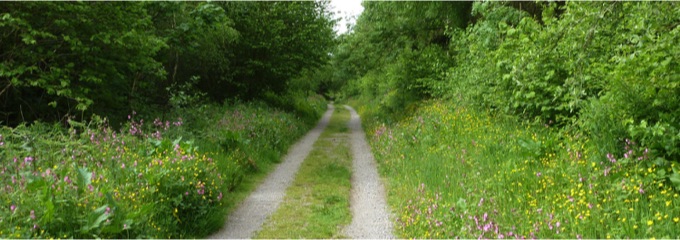Invertebrates
The diversity of habitats found within the site, from densely wooded areas to open glades, rides and bracken covered slopes ensures a rich and varied mixture of invertebrate species.
Some of the wood’s smaller residents may be familiar, such as the seven-spot ladybird (Coccinella septempunctata) or the peacock (Inachis io) and red admiral (Vanessa atalanta) butterflies. Some of the others may not be so familiar.
Almost twenty species of butterfly have been recorded on or near the woods, from the common species mentioned above, to the scarcer species such as the pearl-bordered fritillary (Boloria euphrosyne). Many of these are found in the open areas of the woods, with species such as the speckled wood (Pararge aegeria) sunning itself in the woodland rides. Such habitats are also home to species you are more likely to hear than see – the grasshoppers and crickets. Both common field grasshopper (Chorthippus brunneus) and meadow grasshopper (Chorthippus parallelus) inhabit areas of long grass, while speckled bush crickets (Leptophyes punctatissima) and dark bush crickets (Pholidoptera griseoaptera) are more likely to be encountered in areas with more bramble and young scrub.
A light in the wood at night may result in an encounter with the blood-vein (Timandra comae), lilac beauty (Apeira syringaria), flame shoulder (Ochropleura plecta), maiden's blush (Cyclophora punctaria), setaceous Hebrew character (Xestia c-nigrum) or heart & dart (Agrotis exclamationis). These are just some of the fifty or so wonderfully named moth species to have been recorded at Ruperra - more than double the numbers of species compared to their day-flying relatives.



Speckled wood (Pararge aegeria)
Peacock (Inachis io)
Comma (Polygonia c-album)

Many of the small insect species found in the UK are parasitoid wasps. They specialise in laying their eggs in the larvae of other insect species. When these parasitoids hatch they begin consuming their insect host from the inside out. The sabre wasp (Rhyssa persuasoria) is the biggest parasitoid wasp in the UK . The adult females are about 4 cm long but also have a long ovipositor of about the same length. They parasitise the larvae of the horntail wasp (Urocerus gigas) which lays its eggs in dead and dying conifer trees as well as recently felled timber. The horntail wasp larvae can take up to five years to grow to their full size within tunnels in the dead timber. The sabre wasp can detect these tunnels by tapping on the surface of the wood with its antennae, and when it has located a horntail larvae it bores down into the wood with its long ovipositor and lays an egg in its host.
Other dangers come from insect predators who also patrol the woods. The numerous pools are home to dragonflies and damselflies such as the common hawker (Aeshna juncea) and golden-ringed dragonfly (Cordulegaster boltonii) which can also often be seen hunting along
Sabre wasp (Rhyssa persuasoria)
woodland rides, seeking out other flying insects on which to prey.
However, despite the diversity of invertebrates we already know of in Ruperra, they remain for the most part an under-recorded and under-studied group. So keep your eyes peeled as you may encounter the next mini-beast first for Ruperra!

